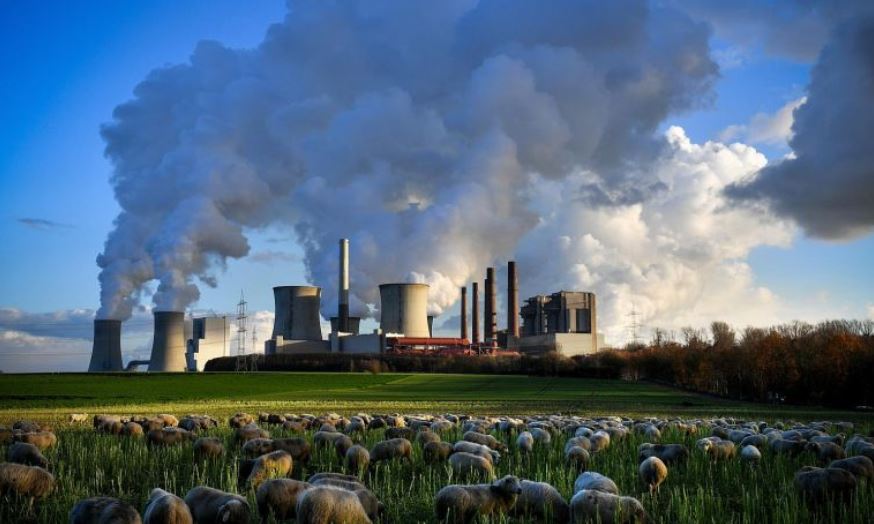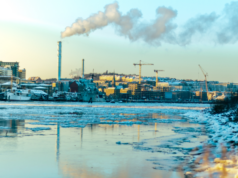Fossil fuels continue to be the world’s primary energy source. When you are putting gas in your car, turning on the heat in your home or watching TV, you are consuming fossil fuels. But our continued reliance on these fuels has serious ecological consequences, and may even eventually lead to the end of human life as we know it.

What Are Fossil Fuels?
Fossil fuels are derived from the remains of living things that died millennia ago. As they decomposed, their fossilized remains were buried under inorganic sediment. Exposed to intense heat and pressure, this organic matter eventually transformed into hydrocarbons. These are organic substances with a high carbon content that can be burned to produce energy.
Fossil fuels are non-renewable energy source since their supply is fixed. Once their reserves are gone, they cannot be replenished in the near future.
To illustrate how limited supplies of fossil fuels are, a 2017 annual report of BP estimated that world proved oil reserves were at 1696.6 billion barrels. At current rates of production, these reserves would last just 50.2 years.
There are three main categories of fossil fuels.
Oil. Also known as petroleum, crude oil is a liquid fuel made mostly out of hydrocarbons. Petroleum is usually found in underground pockets that may be on land or underwater. It is extracted using wells and drilling rigs. Crude oil is transported to refineries where it is processed into gasoline and petrochemicals (which are used to make plastics and pharmaceuticals).
Petroleum may also be found near the surface in oil or tar sands. These are mined by removing the topsoil and trees from the area, then scooping up the oil sands. The oil sands are brought to an on-site processing facility, where hot water is added to extract bitumen. This is processed into synthetic crude oil.
The largest consumer of petroleum products in the transportation sector, followed by the industrial sector, which uses it as a raw material to produce various products. The US is the largest petroleum-consuming country as of 2016, accounting for 20% of total world oil consumption, followed by China at 13 percent.
Coal. This is a brownish-black or black sedimentary rock derived from the fossilized remains of plants that lived millions of years ago. Coal is extracted through underground or surface mining.
There are four main types of coal, which are categorized based on their carbon content and the amount of heat energy they can produce.
- Anthracite contains 86% to 97% carbon and has the highest heating value. It is mainly used in the metals industry.
- Bituminous coal has 45% to 86% carbon content. It is mainly used to generate electricity, as well as in the metals industry, where it is a raw material and fuel used to produce iron and steel.
- Subbituminous coal has 35% to 45% carbon content.
- Lignite has the lowest carbon content at 25% to 35% and the lowest energy content. It is mostly used to generate electricity.
Coal is burned to generate electricity by creating steam to turn turbines. It is also used by industries such as paper and coal to generate heat for their operations. The metals industry uses coal to create coal coke, which is burned to generate the high temperatures needed to make steel.
Natural gas. This fossil fuel is mainly composed of methane, with smaller amounts of nonhydrocarbon gases, such as water vapor and carbon dioxide, and natural gas liquids. It is extracted by drilling wells on formations bearing natural gas.
Once it is extracted, the NGLs and carbon dioxide are removed. The natural gas is then sent to distribution companies through pipelines. It is mainly used by the industrial sector to generate heat for production and the energy sector to create electricity.
The Negative Effects of Fossil Fuel Extraction
Extracting fossil fuels from the earth or sea has long been known to have negative effects on the environment.
For instance, strip mining involves removing rocks and topsoil, and trees from seams to extract the coal underneath. If the coal seam is found on a mountain, the mountaintop will be blasted away.
This causes the destruction of landscapes, as well as wildlife habitats. It also results in erosion of the soil and the destruction of agricultural lands, since it can no longer be used for crop planting.
The disturbed topsoil may also be washed off by rainfall into nearby streams. The soil is often contaminated with toxic substances such as selenium, lead, arsenic, and hydrogen sulfide. These pollutants can then seep into the water table, causing the groundwater to be contaminated, and rendering water supplies unsafe to drink.
While underground coal mining is seen to have fewer negative effects, the land above the mine can collapse. This is because the support structures that hold up the mine tunnels are removed once the mine is no longer active. Thus, these tunnels may collapse, resulting in the destruction of the landscape due to the erosion of vegetation and waste rock.
In addition, since mercury is used in some mining operations, there is the possibility of mercury contamination of nearby water sources. Mercury is a highly toxic chemical, and exposure to even small amounts may result in serious health effects. It can damage the lungs, eyes, and kidneys, as well as the digestive and nervous systems.
Refining petroleum is also a major cause of air pollution. The process releases toxic chemicals into the air such as benzene, xylene and toluene, as well as sulfur dioxide, carbon monoxide and hydrogen sulfide. Some of these chemicals are known carcinogens or can aggravate respiratory conditions such as asthma.
In addition, there is also the risk of oil spills during the transport and drilling process. While large-scale spills such as those from the Exxon Valdez in 1989 get the most media attention, the majority of oil spills that contaminate the ecosystem actually come from illegal dumping, as well as everyday events such as leaks from cars and other forms of transport.
Extracting fossil fuels also has many indirect impacts that harm the environment. For instance, roads and other infrastructure to the extraction sites have to be built, which can disturb natural habitats, affecting animals and plant life. In addition, extraction activities can also facilitate the entry of invasive species into an ecosystem, displacing existing species.
What Is Climate Change?
However, the most serious environmental effect of our continued reliance on fossil fuels is climate change. Unfortunately, this is a very frequently misunderstood concept. To better understand what climate change is, we need to define what “climate” is.
You are probably familiar with ‘weather,’ which refers to short-term changes in atmospheric conditions. For instance, it might rain for a few hours and then clear up afterward. Or the temperature might be cool one day and hot the next.
Climate refers to the usual atmospheric conditions of a certain area. Areas can have different climates depending on a particular season. For instance, a country might be wet and cold during the winter, but then dry and hot during the summer.
Climate is not fixed; it can, and does change over time. You may remember that there were times in the distant past when the Earth’s climate was much colder than it is today. However, the phenomenon is known today as “climate change” refers to changes in the Earth’s average surface temperatures over time.
According to studies, the global temperature has increased by one degree F over the past 100 years. This is why the phenomenon is also referred to as “global warming.” Although this increase may seem slight, it has serious effects on the environment, and may eventually render the earth uninhabitable for human life. These impacts include:
- Increased flooding of coastal areas. Global warming has caused ice caps at the earth’s poles and elsewhere to start melting, causing rises in the sea level. This threatens low-lying and coastal communities with chronic flooding.
- More severe weather. Warmer climates are causing an increase in severe weather including flooding, heat waves, and hurricanes. These events will cost billions of dollars in losses. There may also be more severe consequences such as decreased access to clean drinking water due to prolonged droughts.
- Greater health threats. Hotter temperatures mean an increase in heat-related illnesses and deaths, particularly among vulnerable sectors such as children and the elderly. These illnesses include heat stroke, kidney and cardiovascular diseases, and heat exhaustion.
- Air pollution. As temperatures rise, so do levels of ground-level ozone, which are the result of pollution from factories, vehicles and other sources. Ground-level ozone creates smog, which can worsen the condition of people suffering from pulmonary or cardiac diseases.
- Acidification of the oceans. The world’s oceans are turning more acidic, which threatens marine life and hurts communities that rely on the harvesting of shelled mollusks such as clams and oysters for their livelihood.
Of course, global warming also hurts wildlife. As their habitats grow hotter, many animals and ocean species are moving to higher altitudes or cooler climates. But these movements may not be enough to save them, and extinction rates are skyrocketing.
According to a 2015 study published in the journal Science Advances, billions of local or regional animal populations, including both rare and common species, have been lost over the past decades. This has led researchers to declare that the earth is already undergoing a sixth “mass extinction” due to climate change. This ‘biological annihilation’ not only threatens wildlife but human civilization as well.
Fossil Fuels and Climate Change
The main cause of global warming is the release of greenhouse gases, such as carbon dioxide and methane, into the atmosphere. These greenhouse gases trap heat coming from the Earth in the planet’s atmosphere, resulting in an increase in the average climate over time.
This “greenhouse effect” is caused by human activities, mainly the burning of fossil fuels. When these fuels are burnt to generate energy, they emit carbon, which bonds with oxygen to make carbon dioxide. Although carbon dioxide is released naturally into the atmosphere through human respiration and volcanic eruptions, it is the use of fossil fuels that have greatly increased the levels of atmospheric carbon dioxide.
Another major contributor to global warming is tropical deforestation since forests are burned to reclaim the land, resulting in huge carbon emissions. Deforestation also indicates that there are fewer trees to remove excess carbon dioxide from the atmosphere.
According to the United Nations Intergovernmental Panel on Climate Change, there is more than a 95% likelihood that global warming is the result of human activity over the past fifty years. These findings were revealed in its Fifth Assessment Report, which was compiled by a panel of 1,300 independent scientists from all over the world. The panel also found that industrial activities over the past 150 years have caused atmospheric carbon dioxide levels to increase to 400 parts per million from 150 parts per million.
Unfortunately, despite the overwhelming evidence that climate change is caused by human activity, there are still many critics who deny that global warming is a reality. According to these deniers, the climate changes we are currently seeing are a natural phenomenon. They also claim that it is impossible to establish a definitive connection between extreme weather events and climate change.
But the main reason why many people still deny climate change is that it would require breaking our dependence on fossil fuels. This would not only affect many industries, but it would also require a major change in our lifestyles. In addition, the world’s energy needs continue to grow substantially.
Although developed countries are increasingly turning to renewable energy to meet their needs, developing countries are using more fossil fuels since these remain the cheapest form of energy. In addition, clean energy is mostly used to generate electricity. But the majority of energy consumption comes from vehicles such as cars and airplanes, which are still dependent on fossil fuels.
At present, there is a global initiative in place to stop climate change, in the form of the Paris Agreement. The agreement is a global action plan that was adopted by nearly 200 countries in 2015.
It commits the major emitting countries to reduce pollution that causes climate change and to intensify these commitments over time. In addition, it provides a pathway for rich countries to help poorer ones in their efforts to mitigate climate change. It also provided a framework to monitor and report on signatories’ efforts to achieve their individual climate goals, as well as the collective goals mandated in the agreement.
Unfortunately, in June 2017, US president Donald Trump announced that the US would be withdrawing from the Paris Agreement. This announcement was in fulfillment of a campaign promise he made, claiming that withdrawal would help US businesses. He had earlier stated that the Agreement put the American economy at a permanent disadvantage.
Alternatives to Fossil Fuels
There are many green energy technologies available that use renewable energy sources. These sources are naturally replenishing but limited in the amount of energy they can produce. Thus, shifting to these sources would require us to be more efficient and economical in our energy utilization.
The major types of renewable energy include:
Solar. Solar photovoltaic (PV) cells transform sunlight directly into usable electricity. Solar energy has become a popular alternative for many households. This is because arrays of PV cells can provide enough energy to meet their needs.
There are also solar power plants that produce enough energy to power thousands of households. These may use huge arrays of PV cells or use sunlight to generate steam to run turbines in order to generate electricity.
However, the main limitation of solar energy is that the amount of sunlight reaching earth is not consistent. Thus, you are not assured of a steady source of energy during rainy or cloudy days. Although you can still collect energy during these days, you will notice a drop in the efficiency of your system.
In addition, not every area is suitable for solar panel installation. The area has to not only receive lots of sunlight but also be free of obstructions that could block it.
Another bar to the wider adoption of solar energy is cost. A solar power system is very expensive. It may take years before your energy savings are enough to offset the initial installation costs.
Wind. Electricity is generated from wind using wind turbines. The blades of the turbines are connected to a drive shaft that turns a generator to produce electricity.
As with solar, however, the wind is not consistent. This problem can be addressed, in part, by placing the wind turbines in remote areas that receive more wind and have fewer obstacles that can block its force. In addition, wind turbines are noisy and can negatively affect homeowners and their neighbors.
Hydropower. This energy source generates electricity by using flowing water to turn turbines. In order for this to work, the water has to flow with enough volume and speed. This is why hydropower plants are usually located near dams since openings in the dam can be used to drop water down pipes to turn the turbines.
Hydropower plants may also be built next to rivers, and generate electricity by capturing the kinetic energy of the running water. However, these power plants are unable to determine when and how much electricity will be generated since they have no means of controlling the flow of the water.
Conclusion
Our dependence on fossil fuels as an energy source is tied to the fact that they are relatively cheaper to extract and use compared with other sources. But this ongoing dependence carries with it serious environmental effects.
In fact, if things continue the way they do at present, the next generation could see the global climate becoming inhospitable for human life. This is why we have to start, right now. We need to move away from fossil fuels to more renewable and sustainable energy sources.






